Woolworths’ Organizational Context and Business Operations
VerifiedAdded on 2023/06/04
|10
|2349
|422
AI Summary
This article discusses Woolworths’ organizational context, business operations, supply network system, market segmentation, and adaptation of business model. It also highlights the challenges faced by Woolworths and its strategies to overcome them.
Contribute Materials
Your contribution can guide someone’s learning journey. Share your
documents today.

Running head: OPERATIONS MANAGEMENT
OPERATIONS MANAGEMENT
Name of the Student:
Name of the University:
Author note:
OPERATIONS MANAGEMENT
Name of the Student:
Name of the University:
Author note:
Secure Best Marks with AI Grader
Need help grading? Try our AI Grader for instant feedback on your assignments.
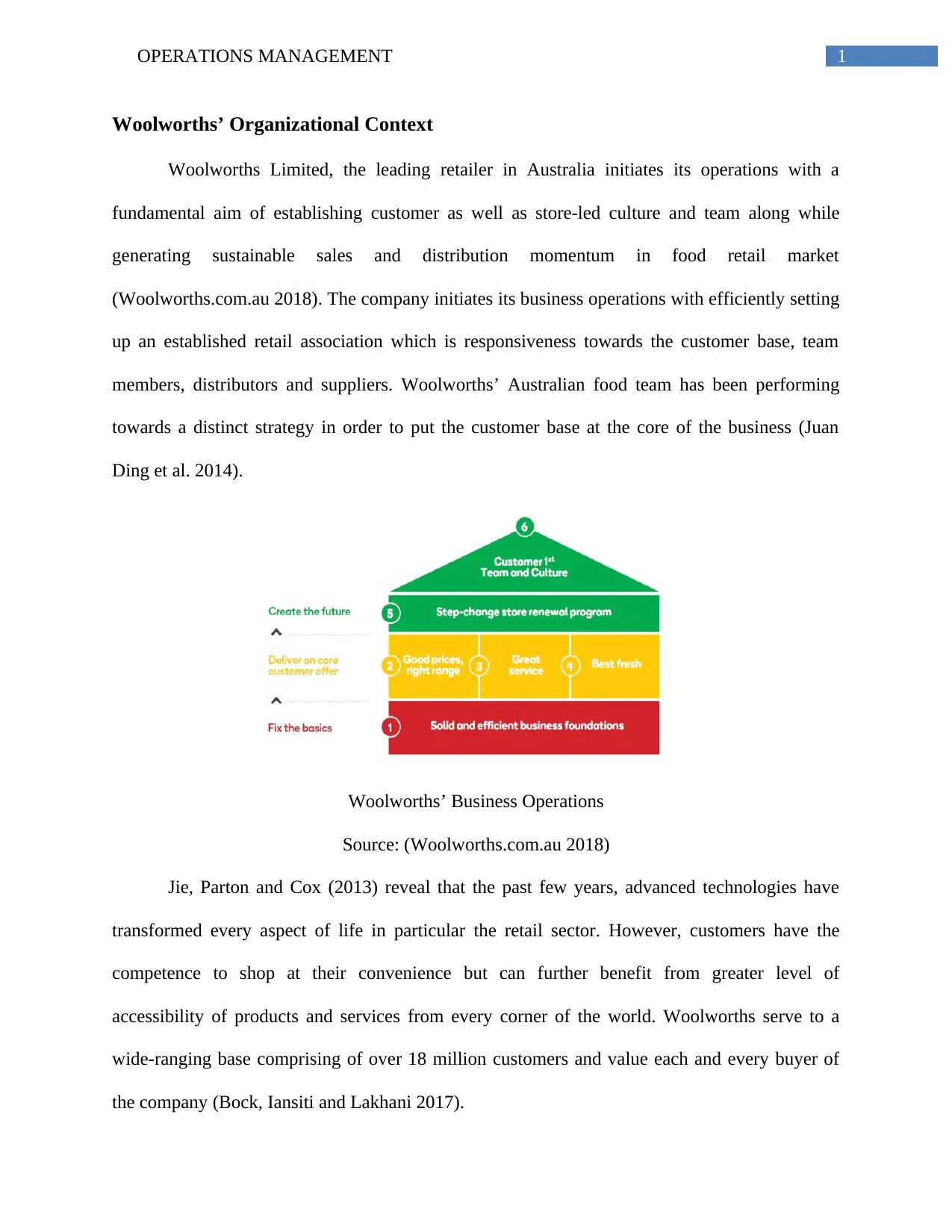
1OPERATIONS MANAGEMENT
Woolworths’ Organizational Context
Woolworths Limited, the leading retailer in Australia initiates its operations with a
fundamental aim of establishing customer as well as store-led culture and team along while
generating sustainable sales and distribution momentum in food retail market
(Woolworths.com.au 2018). The company initiates its business operations with efficiently setting
up an established retail association which is responsiveness towards the customer base, team
members, distributors and suppliers. Woolworths’ Australian food team has been performing
towards a distinct strategy in order to put the customer base at the core of the business (Juan
Ding et al. 2014).
Woolworths’ Business Operations
Source: (Woolworths.com.au 2018)
Jie, Parton and Cox (2013) reveal that the past few years, advanced technologies have
transformed every aspect of life in particular the retail sector. However, customers have the
competence to shop at their convenience but can further benefit from greater level of
accessibility of products and services from every corner of the world. Woolworths serve to a
wide-ranging base comprising of over 18 million customers and value each and every buyer of
the company (Bock, Iansiti and Lakhani 2017).
Woolworths’ Organizational Context
Woolworths Limited, the leading retailer in Australia initiates its operations with a
fundamental aim of establishing customer as well as store-led culture and team along while
generating sustainable sales and distribution momentum in food retail market
(Woolworths.com.au 2018). The company initiates its business operations with efficiently setting
up an established retail association which is responsiveness towards the customer base, team
members, distributors and suppliers. Woolworths’ Australian food team has been performing
towards a distinct strategy in order to put the customer base at the core of the business (Juan
Ding et al. 2014).
Woolworths’ Business Operations
Source: (Woolworths.com.au 2018)
Jie, Parton and Cox (2013) reveal that the past few years, advanced technologies have
transformed every aspect of life in particular the retail sector. However, customers have the
competence to shop at their convenience but can further benefit from greater level of
accessibility of products and services from every corner of the world. Woolworths serve to a
wide-ranging base comprising of over 18 million customers and value each and every buyer of
the company (Bock, Iansiti and Lakhani 2017).
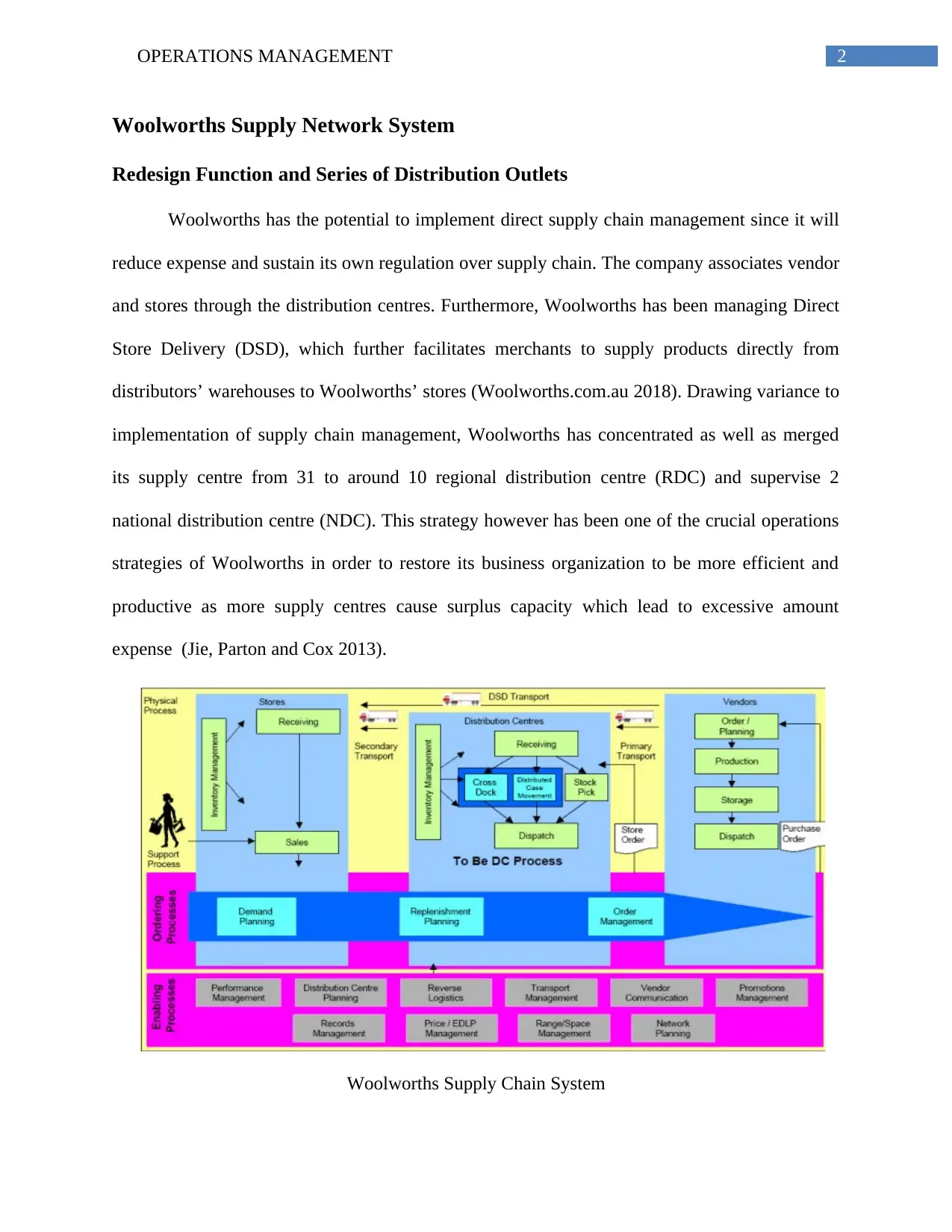
2OPERATIONS MANAGEMENT
Woolworths Supply Network System
Redesign Function and Series of Distribution Outlets
Woolworths has the potential to implement direct supply chain management since it will
reduce expense and sustain its own regulation over supply chain. The company associates vendor
and stores through the distribution centres. Furthermore, Woolworths has been managing Direct
Store Delivery (DSD), which further facilitates merchants to supply products directly from
distributors’ warehouses to Woolworths’ stores (Woolworths.com.au 2018). Drawing variance to
implementation of supply chain management, Woolworths has concentrated as well as merged
its supply centre from 31 to around 10 regional distribution centre (RDC) and supervise 2
national distribution centre (NDC). This strategy however has been one of the crucial operations
strategies of Woolworths in order to restore its business organization to be more efficient and
productive as more supply centres cause surplus capacity which lead to excessive amount
expense (Jie, Parton and Cox 2013).
Woolworths Supply Chain System
Woolworths Supply Network System
Redesign Function and Series of Distribution Outlets
Woolworths has the potential to implement direct supply chain management since it will
reduce expense and sustain its own regulation over supply chain. The company associates vendor
and stores through the distribution centres. Furthermore, Woolworths has been managing Direct
Store Delivery (DSD), which further facilitates merchants to supply products directly from
distributors’ warehouses to Woolworths’ stores (Woolworths.com.au 2018). Drawing variance to
implementation of supply chain management, Woolworths has concentrated as well as merged
its supply centre from 31 to around 10 regional distribution centre (RDC) and supervise 2
national distribution centre (NDC). This strategy however has been one of the crucial operations
strategies of Woolworths in order to restore its business organization to be more efficient and
productive as more supply centres cause surplus capacity which lead to excessive amount
expense (Jie, Parton and Cox 2013).
Woolworths Supply Chain System
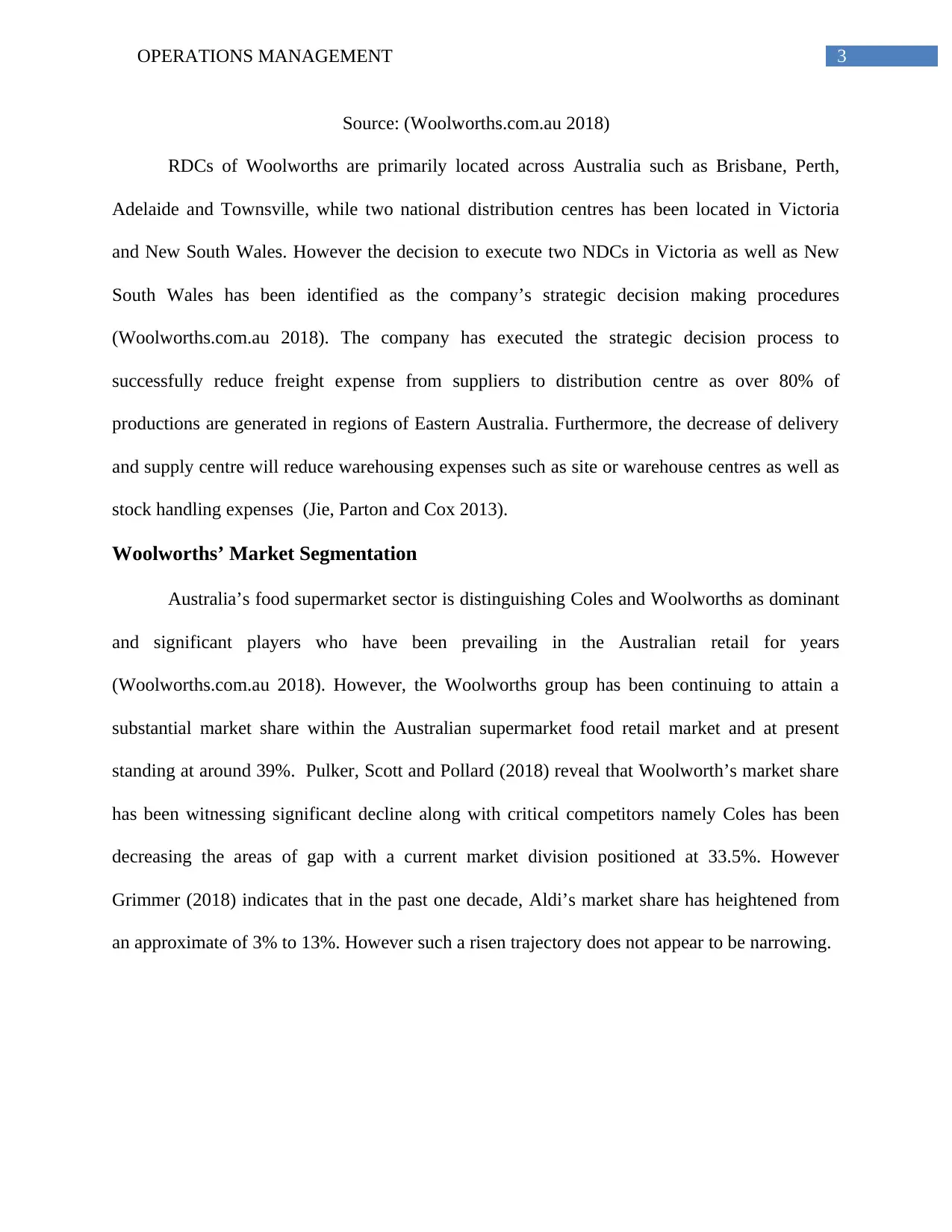
3OPERATIONS MANAGEMENT
Source: (Woolworths.com.au 2018)
RDCs of Woolworths are primarily located across Australia such as Brisbane, Perth,
Adelaide and Townsville, while two national distribution centres has been located in Victoria
and New South Wales. However the decision to execute two NDCs in Victoria as well as New
South Wales has been identified as the company’s strategic decision making procedures
(Woolworths.com.au 2018). The company has executed the strategic decision process to
successfully reduce freight expense from suppliers to distribution centre as over 80% of
productions are generated in regions of Eastern Australia. Furthermore, the decrease of delivery
and supply centre will reduce warehousing expenses such as site or warehouse centres as well as
stock handling expenses (Jie, Parton and Cox 2013).
Woolworths’ Market Segmentation
Australia’s food supermarket sector is distinguishing Coles and Woolworths as dominant
and significant players who have been prevailing in the Australian retail for years
(Woolworths.com.au 2018). However, the Woolworths group has been continuing to attain a
substantial market share within the Australian supermarket food retail market and at present
standing at around 39%. Pulker, Scott and Pollard (2018) reveal that Woolworth’s market share
has been witnessing significant decline along with critical competitors namely Coles has been
decreasing the areas of gap with a current market division positioned at 33.5%. However
Grimmer (2018) indicates that in the past one decade, Aldi’s market share has heightened from
an approximate of 3% to 13%. However such a risen trajectory does not appear to be narrowing.
Source: (Woolworths.com.au 2018)
RDCs of Woolworths are primarily located across Australia such as Brisbane, Perth,
Adelaide and Townsville, while two national distribution centres has been located in Victoria
and New South Wales. However the decision to execute two NDCs in Victoria as well as New
South Wales has been identified as the company’s strategic decision making procedures
(Woolworths.com.au 2018). The company has executed the strategic decision process to
successfully reduce freight expense from suppliers to distribution centre as over 80% of
productions are generated in regions of Eastern Australia. Furthermore, the decrease of delivery
and supply centre will reduce warehousing expenses such as site or warehouse centres as well as
stock handling expenses (Jie, Parton and Cox 2013).
Woolworths’ Market Segmentation
Australia’s food supermarket sector is distinguishing Coles and Woolworths as dominant
and significant players who have been prevailing in the Australian retail for years
(Woolworths.com.au 2018). However, the Woolworths group has been continuing to attain a
substantial market share within the Australian supermarket food retail market and at present
standing at around 39%. Pulker, Scott and Pollard (2018) reveal that Woolworth’s market share
has been witnessing significant decline along with critical competitors namely Coles has been
decreasing the areas of gap with a current market division positioned at 33.5%. However
Grimmer (2018) indicates that in the past one decade, Aldi’s market share has heightened from
an approximate of 3% to 13%. However such a risen trajectory does not appear to be narrowing.
Secure Best Marks with AI Grader
Need help grading? Try our AI Grader for instant feedback on your assignments.
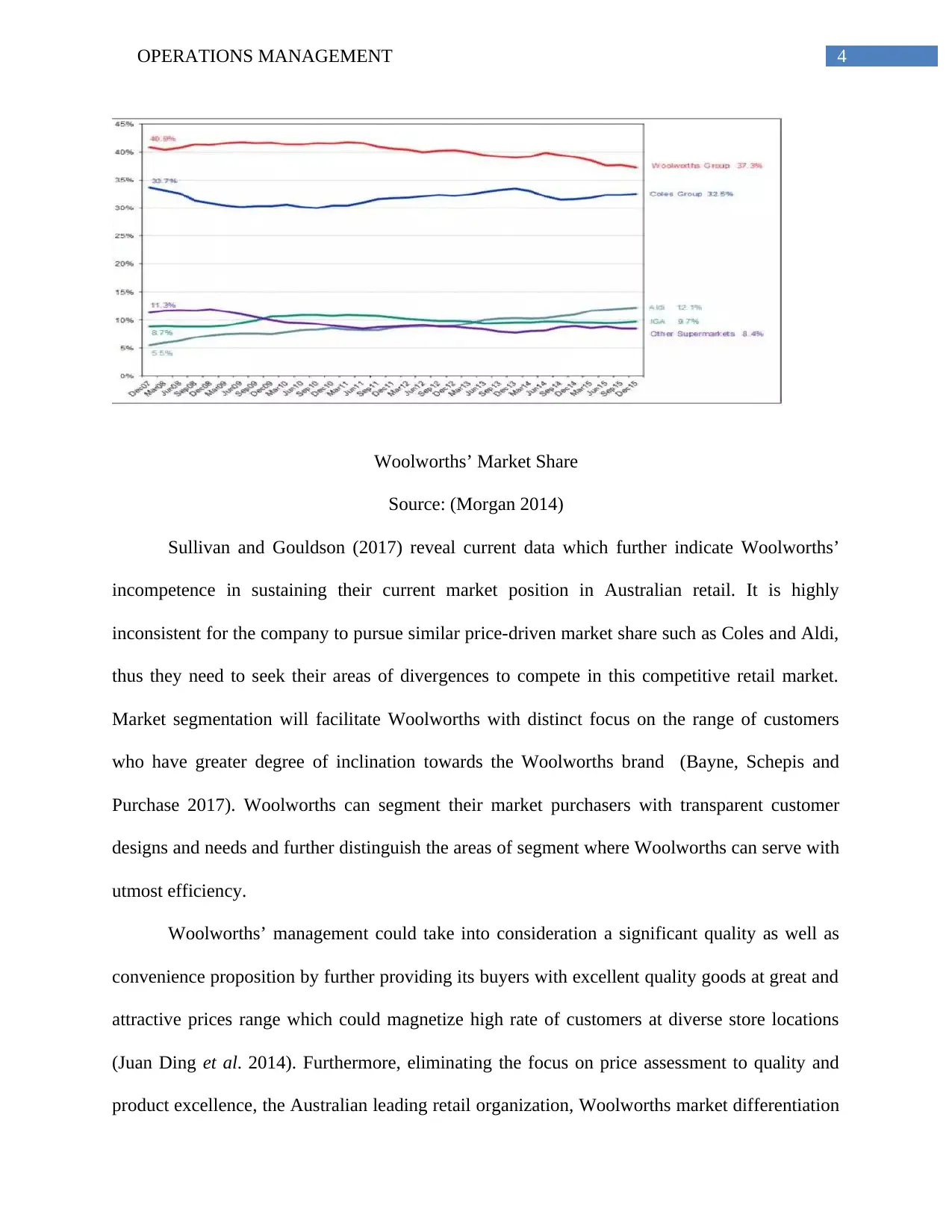
4OPERATIONS MANAGEMENT
Woolworths’ Market Share
Source: (Morgan 2014)
Sullivan and Gouldson (2017) reveal current data which further indicate Woolworths’
incompetence in sustaining their current market position in Australian retail. It is highly
inconsistent for the company to pursue similar price-driven market share such as Coles and Aldi,
thus they need to seek their areas of divergences to compete in this competitive retail market.
Market segmentation will facilitate Woolworths with distinct focus on the range of customers
who have greater degree of inclination towards the Woolworths brand (Bayne, Schepis and
Purchase 2017). Woolworths can segment their market purchasers with transparent customer
designs and needs and further distinguish the areas of segment where Woolworths can serve with
utmost efficiency.
Woolworths’ management could take into consideration a significant quality as well as
convenience proposition by further providing its buyers with excellent quality goods at great and
attractive prices range which could magnetize high rate of customers at diverse store locations
(Juan Ding et al. 2014). Furthermore, eliminating the focus on price assessment to quality and
product excellence, the Australian leading retail organization, Woolworths market differentiation
Woolworths’ Market Share
Source: (Morgan 2014)
Sullivan and Gouldson (2017) reveal current data which further indicate Woolworths’
incompetence in sustaining their current market position in Australian retail. It is highly
inconsistent for the company to pursue similar price-driven market share such as Coles and Aldi,
thus they need to seek their areas of divergences to compete in this competitive retail market.
Market segmentation will facilitate Woolworths with distinct focus on the range of customers
who have greater degree of inclination towards the Woolworths brand (Bayne, Schepis and
Purchase 2017). Woolworths can segment their market purchasers with transparent customer
designs and needs and further distinguish the areas of segment where Woolworths can serve with
utmost efficiency.
Woolworths’ management could take into consideration a significant quality as well as
convenience proposition by further providing its buyers with excellent quality goods at great and
attractive prices range which could magnetize high rate of customers at diverse store locations
(Juan Ding et al. 2014). Furthermore, eliminating the focus on price assessment to quality and
product excellence, the Australian leading retail organization, Woolworths market differentiation
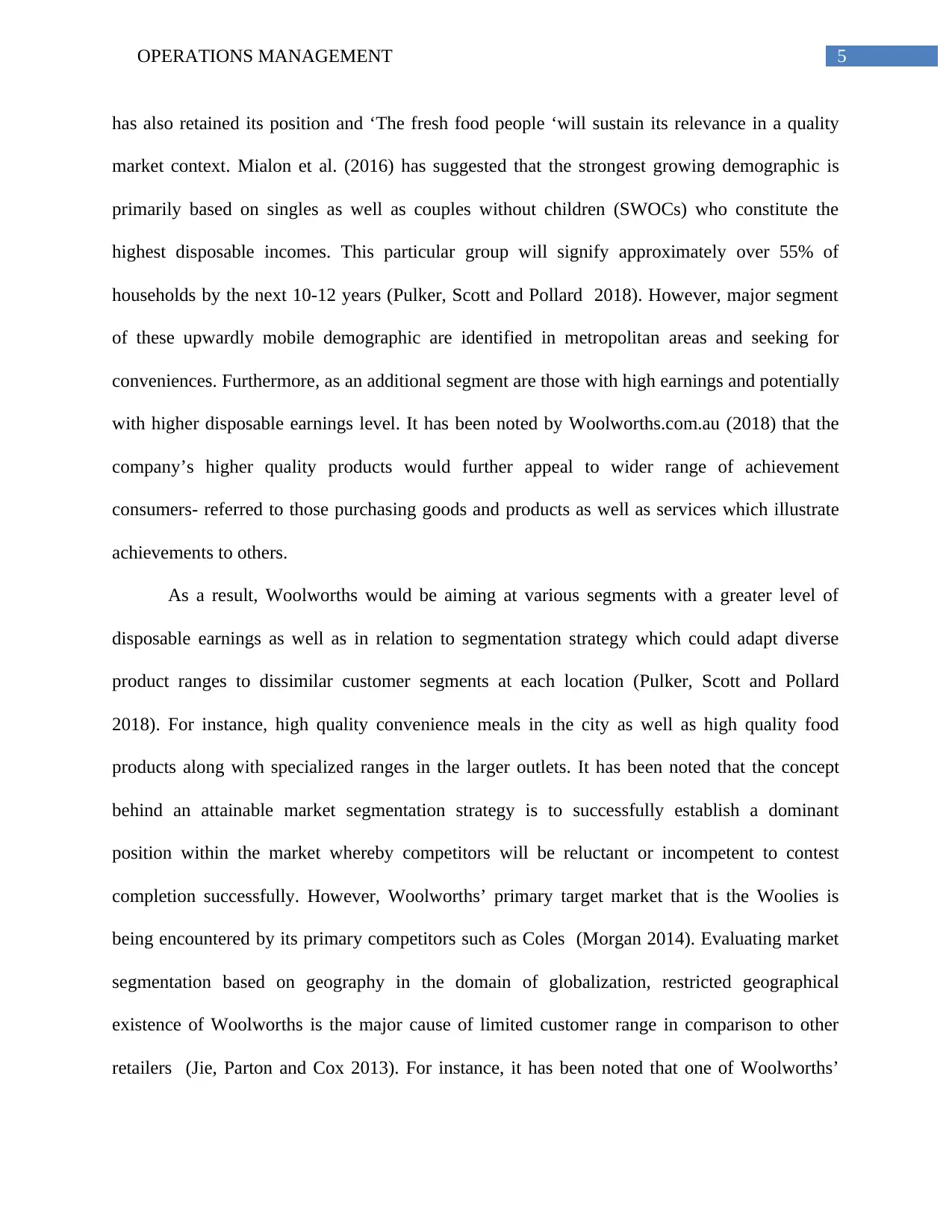
5OPERATIONS MANAGEMENT
has also retained its position and ‘The fresh food people ‘will sustain its relevance in a quality
market context. Mialon et al. (2016) has suggested that the strongest growing demographic is
primarily based on singles as well as couples without children (SWOCs) who constitute the
highest disposable incomes. This particular group will signify approximately over 55% of
households by the next 10-12 years (Pulker, Scott and Pollard 2018). However, major segment
of these upwardly mobile demographic are identified in metropolitan areas and seeking for
conveniences. Furthermore, as an additional segment are those with high earnings and potentially
with higher disposable earnings level. It has been noted by Woolworths.com.au (2018) that the
company’s higher quality products would further appeal to wider range of achievement
consumers- referred to those purchasing goods and products as well as services which illustrate
achievements to others.
As a result, Woolworths would be aiming at various segments with a greater level of
disposable earnings as well as in relation to segmentation strategy which could adapt diverse
product ranges to dissimilar customer segments at each location (Pulker, Scott and Pollard
2018). For instance, high quality convenience meals in the city as well as high quality food
products along with specialized ranges in the larger outlets. It has been noted that the concept
behind an attainable market segmentation strategy is to successfully establish a dominant
position within the market whereby competitors will be reluctant or incompetent to contest
completion successfully. However, Woolworths’ primary target market that is the Woolies is
being encountered by its primary competitors such as Coles (Morgan 2014). Evaluating market
segmentation based on geography in the domain of globalization, restricted geographical
existence of Woolworths is the major cause of limited customer range in comparison to other
retailers (Jie, Parton and Cox 2013). For instance, it has been noted that one of Woolworths’
has also retained its position and ‘The fresh food people ‘will sustain its relevance in a quality
market context. Mialon et al. (2016) has suggested that the strongest growing demographic is
primarily based on singles as well as couples without children (SWOCs) who constitute the
highest disposable incomes. This particular group will signify approximately over 55% of
households by the next 10-12 years (Pulker, Scott and Pollard 2018). However, major segment
of these upwardly mobile demographic are identified in metropolitan areas and seeking for
conveniences. Furthermore, as an additional segment are those with high earnings and potentially
with higher disposable earnings level. It has been noted by Woolworths.com.au (2018) that the
company’s higher quality products would further appeal to wider range of achievement
consumers- referred to those purchasing goods and products as well as services which illustrate
achievements to others.
As a result, Woolworths would be aiming at various segments with a greater level of
disposable earnings as well as in relation to segmentation strategy which could adapt diverse
product ranges to dissimilar customer segments at each location (Pulker, Scott and Pollard
2018). For instance, high quality convenience meals in the city as well as high quality food
products along with specialized ranges in the larger outlets. It has been noted that the concept
behind an attainable market segmentation strategy is to successfully establish a dominant
position within the market whereby competitors will be reluctant or incompetent to contest
completion successfully. However, Woolworths’ primary target market that is the Woolies is
being encountered by its primary competitors such as Coles (Morgan 2014). Evaluating market
segmentation based on geography in the domain of globalization, restricted geographical
existence of Woolworths is the major cause of limited customer range in comparison to other
retailers (Jie, Parton and Cox 2013). For instance, it has been noted that one of Woolworths’
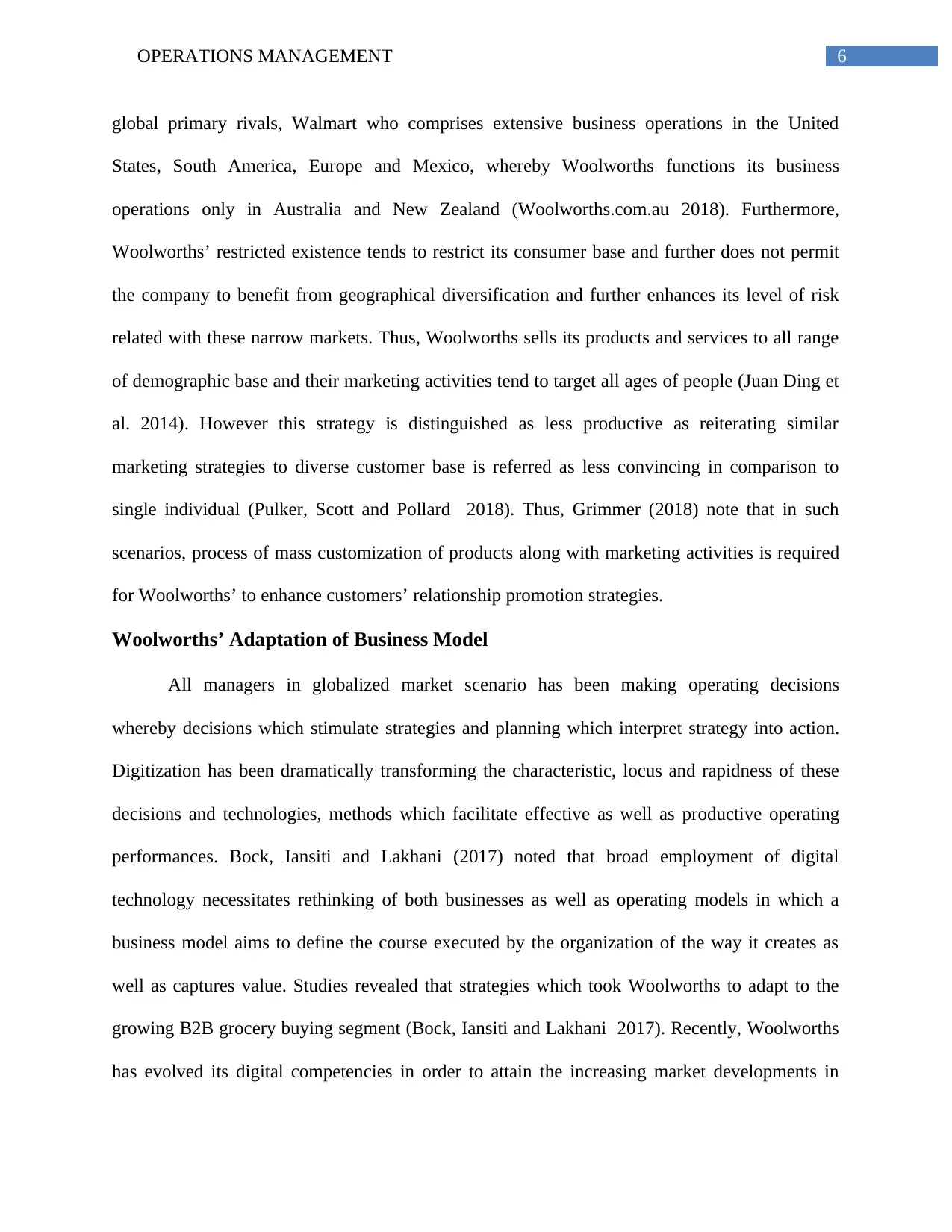
6OPERATIONS MANAGEMENT
global primary rivals, Walmart who comprises extensive business operations in the United
States, South America, Europe and Mexico, whereby Woolworths functions its business
operations only in Australia and New Zealand (Woolworths.com.au 2018). Furthermore,
Woolworths’ restricted existence tends to restrict its consumer base and further does not permit
the company to benefit from geographical diversification and further enhances its level of risk
related with these narrow markets. Thus, Woolworths sells its products and services to all range
of demographic base and their marketing activities tend to target all ages of people (Juan Ding et
al. 2014). However this strategy is distinguished as less productive as reiterating similar
marketing strategies to diverse customer base is referred as less convincing in comparison to
single individual (Pulker, Scott and Pollard 2018). Thus, Grimmer (2018) note that in such
scenarios, process of mass customization of products along with marketing activities is required
for Woolworths’ to enhance customers’ relationship promotion strategies.
Woolworths’ Adaptation of Business Model
All managers in globalized market scenario has been making operating decisions
whereby decisions which stimulate strategies and planning which interpret strategy into action.
Digitization has been dramatically transforming the characteristic, locus and rapidness of these
decisions and technologies, methods which facilitate effective as well as productive operating
performances. Bock, Iansiti and Lakhani (2017) noted that broad employment of digital
technology necessitates rethinking of both businesses as well as operating models in which a
business model aims to define the course executed by the organization of the way it creates as
well as captures value. Studies revealed that strategies which took Woolworths to adapt to the
growing B2B grocery buying segment (Bock, Iansiti and Lakhani 2017). Recently, Woolworths
has evolved its digital competencies in order to attain the increasing market developments in
global primary rivals, Walmart who comprises extensive business operations in the United
States, South America, Europe and Mexico, whereby Woolworths functions its business
operations only in Australia and New Zealand (Woolworths.com.au 2018). Furthermore,
Woolworths’ restricted existence tends to restrict its consumer base and further does not permit
the company to benefit from geographical diversification and further enhances its level of risk
related with these narrow markets. Thus, Woolworths sells its products and services to all range
of demographic base and their marketing activities tend to target all ages of people (Juan Ding et
al. 2014). However this strategy is distinguished as less productive as reiterating similar
marketing strategies to diverse customer base is referred as less convincing in comparison to
single individual (Pulker, Scott and Pollard 2018). Thus, Grimmer (2018) note that in such
scenarios, process of mass customization of products along with marketing activities is required
for Woolworths’ to enhance customers’ relationship promotion strategies.
Woolworths’ Adaptation of Business Model
All managers in globalized market scenario has been making operating decisions
whereby decisions which stimulate strategies and planning which interpret strategy into action.
Digitization has been dramatically transforming the characteristic, locus and rapidness of these
decisions and technologies, methods which facilitate effective as well as productive operating
performances. Bock, Iansiti and Lakhani (2017) noted that broad employment of digital
technology necessitates rethinking of both businesses as well as operating models in which a
business model aims to define the course executed by the organization of the way it creates as
well as captures value. Studies revealed that strategies which took Woolworths to adapt to the
growing B2B grocery buying segment (Bock, Iansiti and Lakhani 2017). Recently, Woolworths
has evolved its digital competencies in order to attain the increasing market developments in
Paraphrase This Document
Need a fresh take? Get an instant paraphrase of this document with our AI Paraphraser
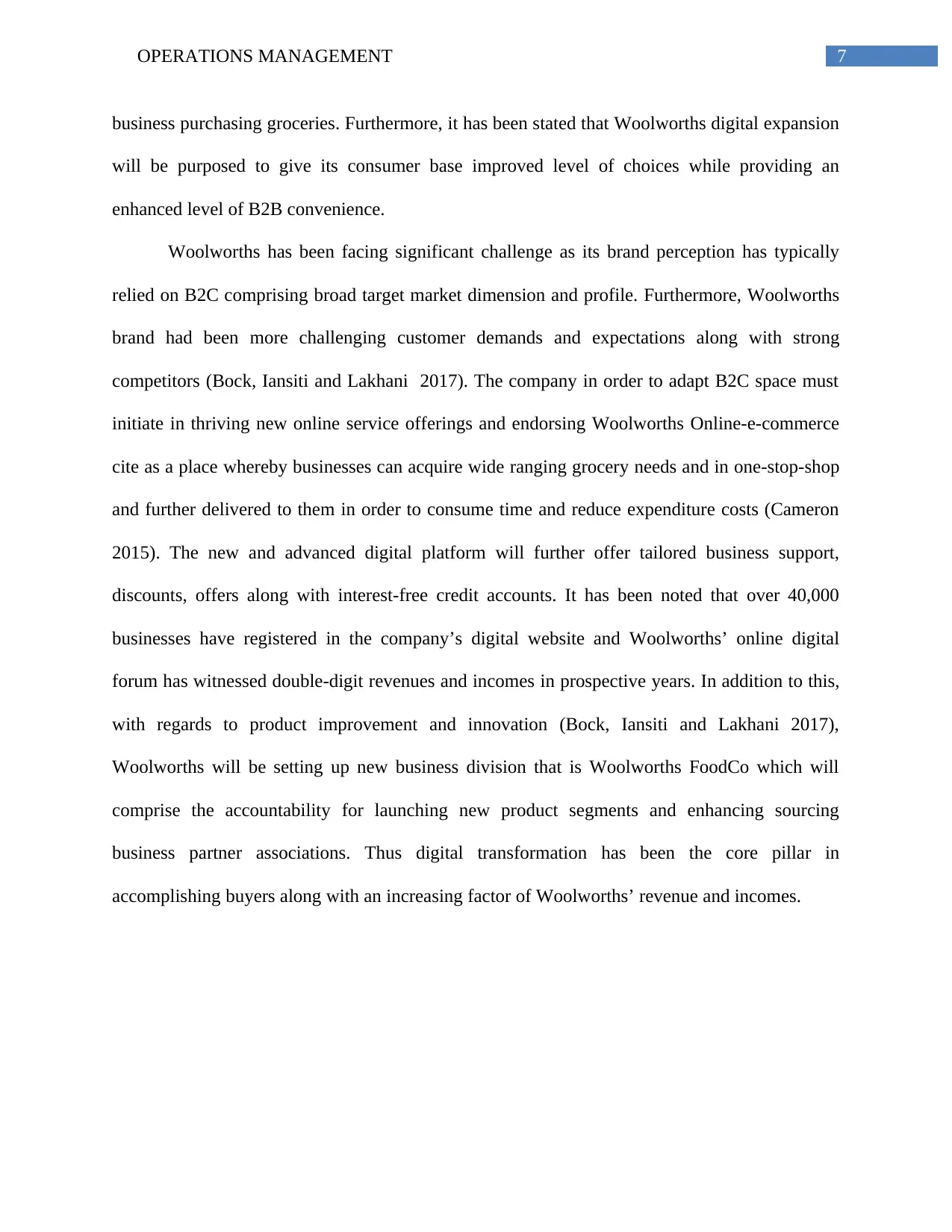
7OPERATIONS MANAGEMENT
business purchasing groceries. Furthermore, it has been stated that Woolworths digital expansion
will be purposed to give its consumer base improved level of choices while providing an
enhanced level of B2B convenience.
Woolworths has been facing significant challenge as its brand perception has typically
relied on B2C comprising broad target market dimension and profile. Furthermore, Woolworths
brand had been more challenging customer demands and expectations along with strong
competitors (Bock, Iansiti and Lakhani 2017). The company in order to adapt B2C space must
initiate in thriving new online service offerings and endorsing Woolworths Online-e-commerce
cite as a place whereby businesses can acquire wide ranging grocery needs and in one-stop-shop
and further delivered to them in order to consume time and reduce expenditure costs (Cameron
2015). The new and advanced digital platform will further offer tailored business support,
discounts, offers along with interest-free credit accounts. It has been noted that over 40,000
businesses have registered in the company’s digital website and Woolworths’ online digital
forum has witnessed double-digit revenues and incomes in prospective years. In addition to this,
with regards to product improvement and innovation (Bock, Iansiti and Lakhani 2017),
Woolworths will be setting up new business division that is Woolworths FoodCo which will
comprise the accountability for launching new product segments and enhancing sourcing
business partner associations. Thus digital transformation has been the core pillar in
accomplishing buyers along with an increasing factor of Woolworths’ revenue and incomes.
business purchasing groceries. Furthermore, it has been stated that Woolworths digital expansion
will be purposed to give its consumer base improved level of choices while providing an
enhanced level of B2B convenience.
Woolworths has been facing significant challenge as its brand perception has typically
relied on B2C comprising broad target market dimension and profile. Furthermore, Woolworths
brand had been more challenging customer demands and expectations along with strong
competitors (Bock, Iansiti and Lakhani 2017). The company in order to adapt B2C space must
initiate in thriving new online service offerings and endorsing Woolworths Online-e-commerce
cite as a place whereby businesses can acquire wide ranging grocery needs and in one-stop-shop
and further delivered to them in order to consume time and reduce expenditure costs (Cameron
2015). The new and advanced digital platform will further offer tailored business support,
discounts, offers along with interest-free credit accounts. It has been noted that over 40,000
businesses have registered in the company’s digital website and Woolworths’ online digital
forum has witnessed double-digit revenues and incomes in prospective years. In addition to this,
with regards to product improvement and innovation (Bock, Iansiti and Lakhani 2017),
Woolworths will be setting up new business division that is Woolworths FoodCo which will
comprise the accountability for launching new product segments and enhancing sourcing
business partner associations. Thus digital transformation has been the core pillar in
accomplishing buyers along with an increasing factor of Woolworths’ revenue and incomes.
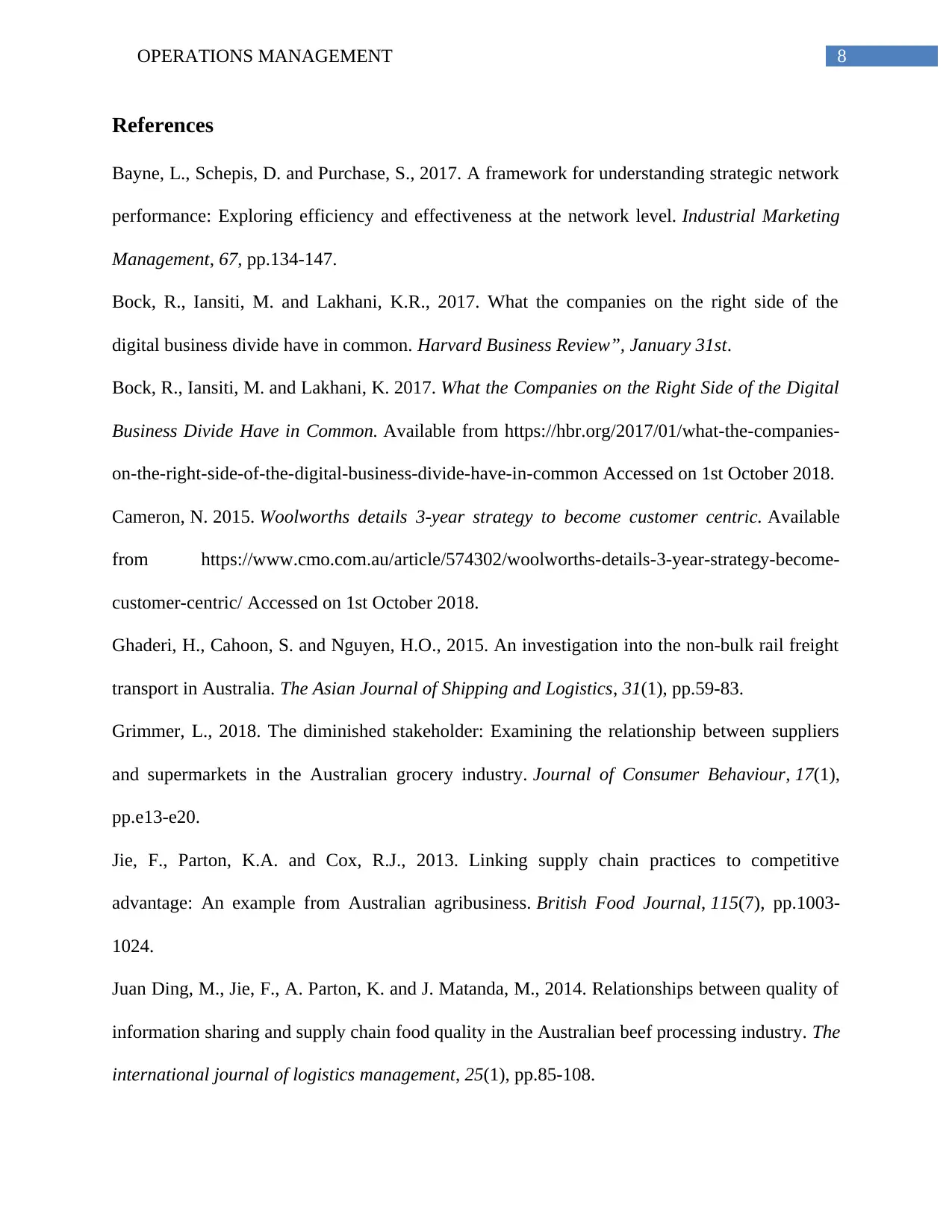
8OPERATIONS MANAGEMENT
References
Bayne, L., Schepis, D. and Purchase, S., 2017. A framework for understanding strategic network
performance: Exploring efficiency and effectiveness at the network level. Industrial Marketing
Management, 67, pp.134-147.
Bock, R., Iansiti, M. and Lakhani, K.R., 2017. What the companies on the right side of the
digital business divide have in common. Harvard Business Review”, January 31st.
Bock, R., Iansiti, M. and Lakhani, K. 2017. What the Companies on the Right Side of the Digital
Business Divide Have in Common. Available from https://hbr.org/2017/01/what-the-companies-
on-the-right-side-of-the-digital-business-divide-have-in-common Accessed on 1st October 2018.
Cameron, N. 2015. Woolworths details 3-year strategy to become customer centric. Available
from https://www.cmo.com.au/article/574302/woolworths-details-3-year-strategy-become-
customer-centric/ Accessed on 1st October 2018.
Ghaderi, H., Cahoon, S. and Nguyen, H.O., 2015. An investigation into the non-bulk rail freight
transport in Australia. The Asian Journal of Shipping and Logistics, 31(1), pp.59-83.
Grimmer, L., 2018. The diminished stakeholder: Examining the relationship between suppliers
and supermarkets in the Australian grocery industry. Journal of Consumer Behaviour, 17(1),
pp.e13-e20.
Jie, F., Parton, K.A. and Cox, R.J., 2013. Linking supply chain practices to competitive
advantage: An example from Australian agribusiness. British Food Journal, 115(7), pp.1003-
1024.
Juan Ding, M., Jie, F., A. Parton, K. and J. Matanda, M., 2014. Relationships between quality of
information sharing and supply chain food quality in the Australian beef processing industry. The
international journal of logistics management, 25(1), pp.85-108.
References
Bayne, L., Schepis, D. and Purchase, S., 2017. A framework for understanding strategic network
performance: Exploring efficiency and effectiveness at the network level. Industrial Marketing
Management, 67, pp.134-147.
Bock, R., Iansiti, M. and Lakhani, K.R., 2017. What the companies on the right side of the
digital business divide have in common. Harvard Business Review”, January 31st.
Bock, R., Iansiti, M. and Lakhani, K. 2017. What the Companies on the Right Side of the Digital
Business Divide Have in Common. Available from https://hbr.org/2017/01/what-the-companies-
on-the-right-side-of-the-digital-business-divide-have-in-common Accessed on 1st October 2018.
Cameron, N. 2015. Woolworths details 3-year strategy to become customer centric. Available
from https://www.cmo.com.au/article/574302/woolworths-details-3-year-strategy-become-
customer-centric/ Accessed on 1st October 2018.
Ghaderi, H., Cahoon, S. and Nguyen, H.O., 2015. An investigation into the non-bulk rail freight
transport in Australia. The Asian Journal of Shipping and Logistics, 31(1), pp.59-83.
Grimmer, L., 2018. The diminished stakeholder: Examining the relationship between suppliers
and supermarkets in the Australian grocery industry. Journal of Consumer Behaviour, 17(1),
pp.e13-e20.
Jie, F., Parton, K.A. and Cox, R.J., 2013. Linking supply chain practices to competitive
advantage: An example from Australian agribusiness. British Food Journal, 115(7), pp.1003-
1024.
Juan Ding, M., Jie, F., A. Parton, K. and J. Matanda, M., 2014. Relationships between quality of
information sharing and supply chain food quality in the Australian beef processing industry. The
international journal of logistics management, 25(1), pp.85-108.
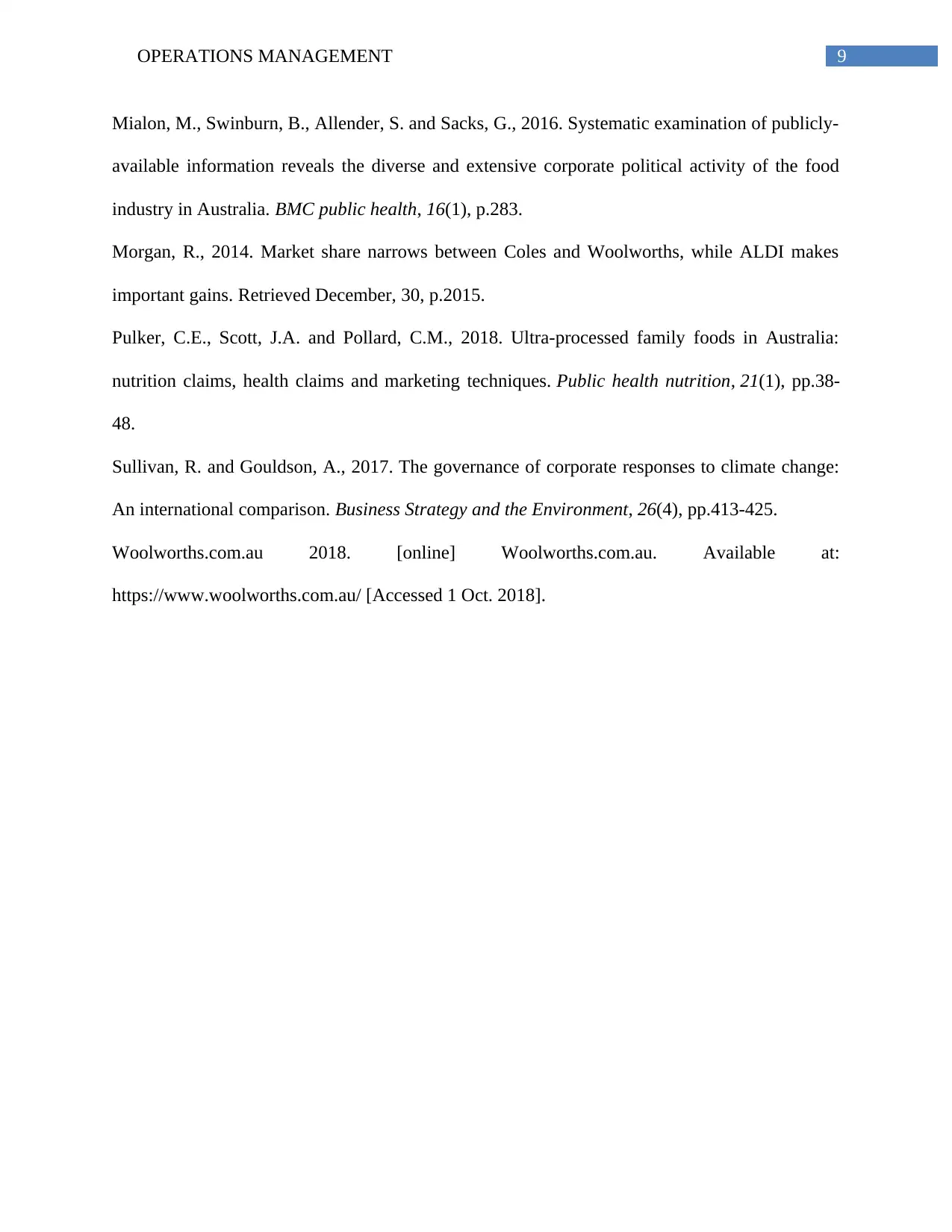
9OPERATIONS MANAGEMENT
Mialon, M., Swinburn, B., Allender, S. and Sacks, G., 2016. Systematic examination of publicly-
available information reveals the diverse and extensive corporate political activity of the food
industry in Australia. BMC public health, 16(1), p.283.
Morgan, R., 2014. Market share narrows between Coles and Woolworths, while ALDI makes
important gains. Retrieved December, 30, p.2015.
Pulker, C.E., Scott, J.A. and Pollard, C.M., 2018. Ultra-processed family foods in Australia:
nutrition claims, health claims and marketing techniques. Public health nutrition, 21(1), pp.38-
48.
Sullivan, R. and Gouldson, A., 2017. The governance of corporate responses to climate change:
An international comparison. Business Strategy and the Environment, 26(4), pp.413-425.
Woolworths.com.au 2018. [online] Woolworths.com.au. Available at:
https://www.woolworths.com.au/ [Accessed 1 Oct. 2018].
Mialon, M., Swinburn, B., Allender, S. and Sacks, G., 2016. Systematic examination of publicly-
available information reveals the diverse and extensive corporate political activity of the food
industry in Australia. BMC public health, 16(1), p.283.
Morgan, R., 2014. Market share narrows between Coles and Woolworths, while ALDI makes
important gains. Retrieved December, 30, p.2015.
Pulker, C.E., Scott, J.A. and Pollard, C.M., 2018. Ultra-processed family foods in Australia:
nutrition claims, health claims and marketing techniques. Public health nutrition, 21(1), pp.38-
48.
Sullivan, R. and Gouldson, A., 2017. The governance of corporate responses to climate change:
An international comparison. Business Strategy and the Environment, 26(4), pp.413-425.
Woolworths.com.au 2018. [online] Woolworths.com.au. Available at:
https://www.woolworths.com.au/ [Accessed 1 Oct. 2018].
1 out of 10
Related Documents
Your All-in-One AI-Powered Toolkit for Academic Success.
+13062052269
info@desklib.com
Available 24*7 on WhatsApp / Email
![[object Object]](/_next/static/media/star-bottom.7253800d.svg)
Unlock your academic potential
© 2024 | Zucol Services PVT LTD | All rights reserved.





